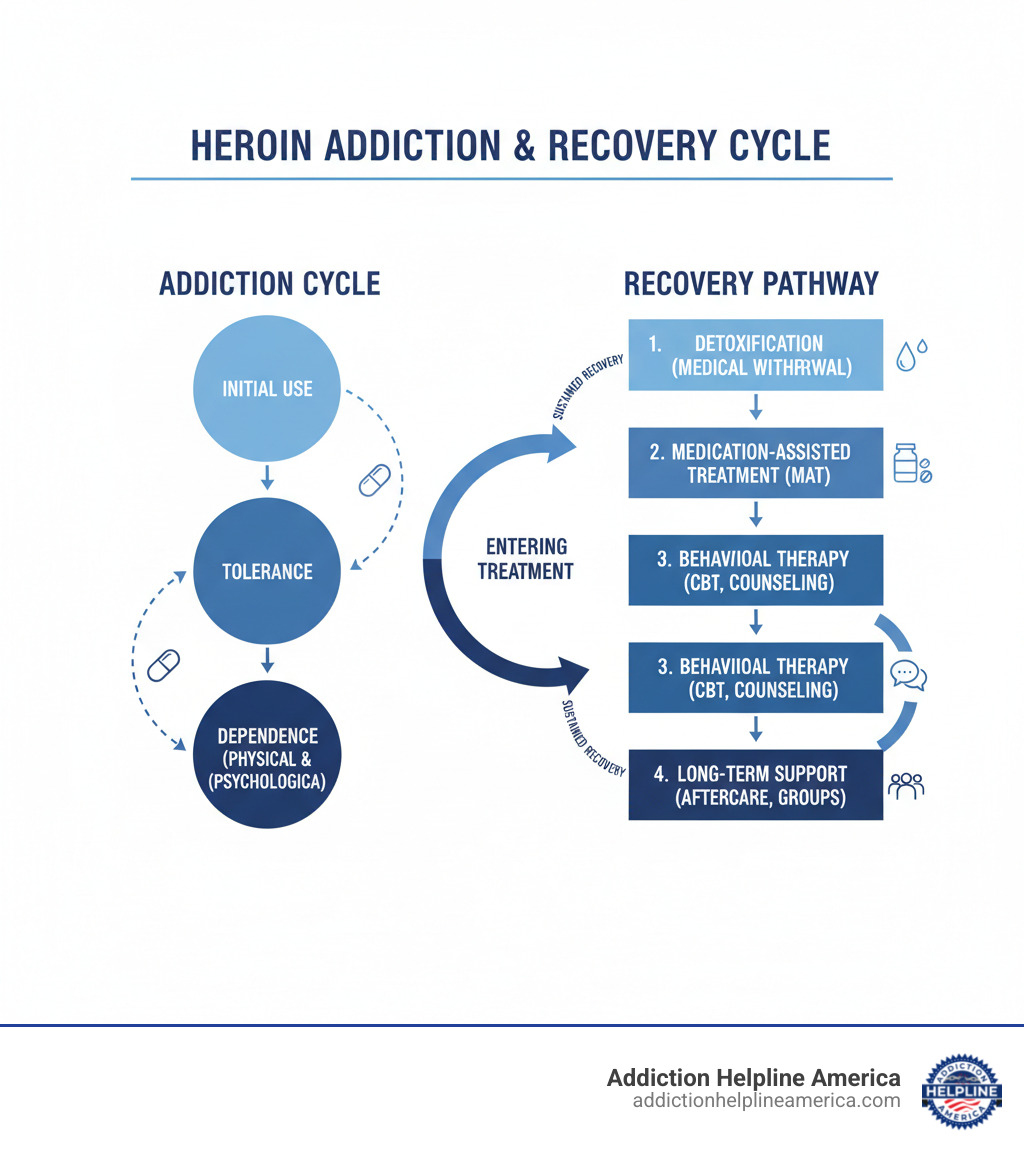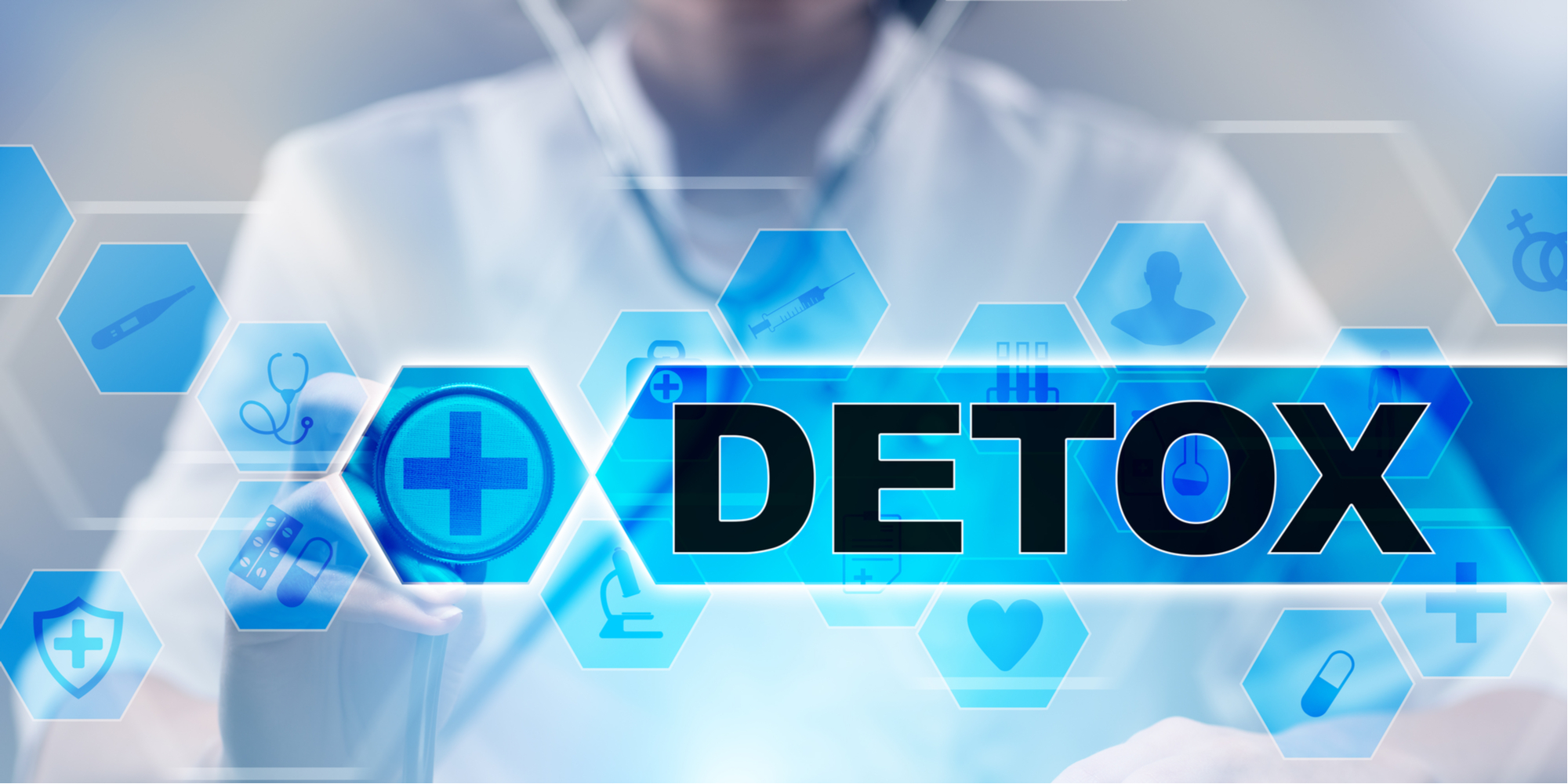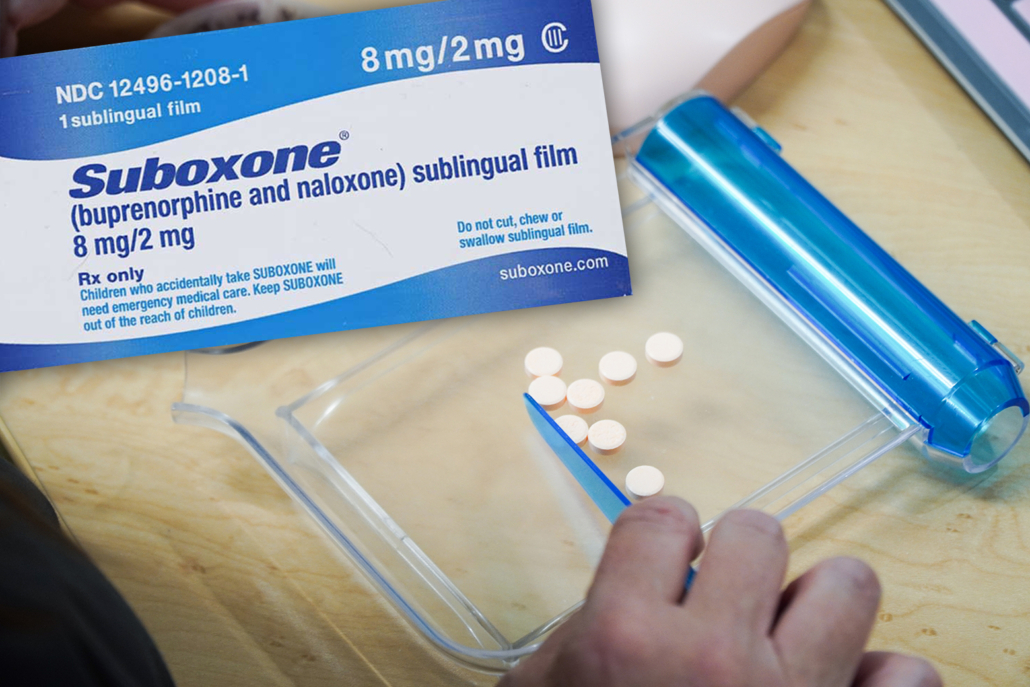Your Journey to a Healthier Life Starts Here
Free Insurance Verification
Verify Your Treatment Coverage
Verify Your Treatment Coverage
Heroin Addiction Treatment is a comprehensive approach combining medical detox, medication-assisted treatment (MAT), and behavioral therapies. Effective treatment addresses both the physical and psychological aspects of addiction, offering a path to lasting recovery.
Quick Overview: What Heroin Addiction Treatment Includes
According to the 2022 National Survey on Drug Use and Health, 900,000 people met the criteria for heroin use disorder. The good news is that recovery is possible. Research shows that treatment increases program retention and decreases drug use, disease transmission, and criminal activity.
Heroin creates intense dependence by flooding the brain’s opioid receptors with dopamine, making it extremely difficult to quit alone. Severe withdrawal symptoms often drive people back to using.
But treatment works. Through inpatient or outpatient programs, effective Heroin Addiction Treatment addresses the whole person, tackling mental health issues, teaching coping skills, and providing medical support for safe withdrawal.
At Addiction Helpline America, we’ve helped countless individuals find the path to recovery. Our team connects you with the right resources, support, and care to help you or your loved one reclaim a life free from addiction.

Recognizing the signs of heroin use disorder is the first step toward getting help. The signs can be physical, behavioral, and psychological.
Physically, look for constricted (pinpoint) pupils, extreme drowsiness or “nodding off,” slurred speech, and dry mouth. Other signs include nausea, severe itching, track marks from injection, sudden weight loss, and neglected hygiene.
Behaviorally, a pattern of secrecy and deception emerges. This includes lying about activities, spending excessive time getting and using heroin, and neglecting responsibilities at work or home. A loss of interest in former hobbies and a constant, unexplained need for money are also common.
Psychologically, watch for intense cravings, dramatic mood swings, irritability, and deepening depression or anxiety. Apathy and a loss of interest in once-enjoyed activities are also key symptoms.
When someone meets several of these criteria, it’s time to seek professional help.
Heroin attacks the entire body, with both immediate and long-term consequences.
Short-term effects include a rush of euphoria, followed by drowsiness (“nodding off”), clouded thinking, and heavy limbs. Dry mouth, nausea, and severe itching are common. The most dangerous effect is respiratory depression, which can slow or stop breathing, leading to overdose.
Long-term effects are devastating and can include collapsed veins, abscesses, and serious infections of the heart lining. Liver and kidney disease, chronic constipation, and hormonal imbalances are also common. The brain’s white matter continues to deteriorate, causing cognitive impairment, while mental health issues like depression and anxiety often worsen.
Two of the biggest threats from heroin use are overdose and infectious diseases.
Overdose is a primary danger. It occurs when heroin slows breathing to a fatal level. The risk is higher than ever due to fentanyl, a synthetic opioid 50-100 times more potent than morphine, which is often mixed with heroin without the user’s knowledge. The risk of overdose also increases significantly after a period of abstinence (e.g., after detox or jail time), as tolerance drops. Using the same previous dose can be lethal. Naloxone (Narcan) can temporarily reverse an opioid overdose by blocking its effects, but immediate medical attention is still critical. For more detailed information about heroin and its effects, you can check out scientific research on heroin.
Infectious diseases are another major risk, especially for those who inject. Sharing needles can transmit blood-borne viruses like HIV/AIDS and Hepatitis C. Unsterile practices also lead to bacterial infections, abscesses, and endocarditis (a heart valve infection).
These immediate dangers are why waiting to seek Heroin Addiction Treatment is so risky. The longer someone uses, the higher the chance of facing a life-threatening complication.
Recovery from heroin addiction is a unique journey for everyone, requiring an individualized and compassionate approach. Effective Heroin Addiction Treatment provides a continuum of care, addressing physical, mental, and emotional challenges. At Addiction Helpline America, we connect you with programs that treat the whole person.

The first step is often medically supervised detoxification. Withdrawal can be uncomfortable and sometimes dangerous, which is why professional oversight is essential. Detox manages the physical dependence on heroin but is not a cure; it must be followed by further treatment to address the psychological aspects of addiction.
Withdrawal symptoms, often starting within 6-12 hours and peaking at 2-3 days, feel like a severe flu. They include muscle and bone pain, cramping, cold flashes, diarrhea, nausea, and vomiting. These are coupled with intense anxiety, depression, and powerful cravings.
In a supervised detox, healthcare professionals monitor you 24/7, using medications like lofexidine, methadone, or buprenorphine to ease symptoms and prevent complications. This support makes the process safer and increases the likelihood of successfully completing this first phase. If you’d like to learn more about what happens during detox, More info about heroin detox offers detailed clinical information.

Take the first step towards a healthier life! Call now to connect with our compassionate team and start your recovery journey today. Your path to healing awaits!
Our recovery specialists are available 24/7 to provide support, and all calls are confidential and free. Reach out anytime – we’re here to help!
After detox, the next step is choosing the right treatment program. The decision between inpatient and outpatient care depends on addiction severity, your home support system, and other health issues.
Inpatient rehab (residential treatment) involves living at a facility 24/7 for a set period (e.g., 30-90 days). This immersive, structured environment removes you from triggers and provides constant medical and therapeutic support. It is ideal for those with severe addiction, co-occurring disorders, or an unsupportive home environment.
Outpatient rehab allows you to live at home while attending treatment sessions several times a week. This flexibility lets you maintain work or family duties. Levels of care range from traditional outpatient (a few hours a week) to Intensive Outpatient Programs (IOPs) and Partial Hospitalization Programs (PHPs) that offer more structured, intensive therapy. Outpatient is best for those with milder addiction or a strong home support system.
| Feature | Inpatient Rehab | Outpatient Rehab |
|---|---|---|
| Location | Live at the facility | Live at home, attend sessions |
| Supervision | 24/7 medical and therapeutic support | Scheduled sessions, less direct supervision |
| Structure | Highly structured daily routine | Flexible schedule, self-management required |
| Intensity | High (immersive, intensive) | Varies (Traditional, IOP, PHP) |
| Cost | Generally higher | Generally lower |
| Support System | Built-in community within facility | Relies on external support (family, peers, groups) |
| Ideal For Whom | Severe addiction, co-occurring disorders, high relapse risk | Milder addiction, step-down from inpatient, stable home life |
Many people with heroin addiction also have mental health issues like depression, anxiety, PTSD, or bipolar disorder. This is called a dual diagnosis or co-occurring disorders. The conditions often fuel each other, making it essential to treat both simultaneously.
An integrated treatment approach addresses addiction and mental health as equally important. After a comprehensive assessment, a coordinated team provides therapies like Cognitive-Behavioral Therapy (CBT) or Dialectical Behavior Therapy (DBT) and may prescribe psychiatric medications that are compatible with addiction treatment.
Ignoring underlying mental health issues is a major cause of relapse. Treating the whole person is key to building a strong foundation for lasting recovery. For more information on this integrated approach, Information on dual diagnosis treatment provides valuable resources.
Medication-Assisted Treatment (MAT) is a part of Heroin Addiction Treatment. It combines FDA-approved medications with counseling to give people a real chance at recovery. Evidence shows MAT increases treatment retention while decreasing illicit drug use, disease transmission, and criminal activity.

MAT medications act on the same opioid receptors as heroin but in a controlled and safer way. They stabilize the brain by reducing cravings and withdrawal symptoms without producing the euphoric high that fuels addiction.
Opioid Agonists like Methadone fully activate opioid receptors. This long-acting medication, typically dispensed at specialized clinics, prevents withdrawal and cravings without the rush of heroin. It can be used for short-term detox or long-term maintenance. For more detailed information, see Methadone.
Partial Opioid Agonists like Buprenorphine activate receptors but have a “ceiling effect,” reducing overdose risk. Approved in 2002, it expanded access to treatment as certified physicians could prescribe it from their offices. Buprenorphine is available as Subutex (buprenorphine only) or Suboxone (combined with naloxone to deter misuse). Newer long-acting injectable buprenorphine (Buvidal®, Sublocade®) is given weekly or monthly, improving adherence and convenience. More on this can be found at Details on Buprenorphine and Long acting injectable buprenorphine, Victorian Government.
Opioid Antagonists like Naltrexone block opioid receptors entirely. If a person uses heroin while on naltrexone, they will feel no effect, removing the incentive to use. Naltrexone is used after detox and comes as a daily pill or a once-monthly injection called Vivitrol®, which helps prevent relapse. A person must be opioid-free for 7-10 days before starting naltrexone to avoid precipitating severe withdrawal. For more information, see Naltrexone.
Benefits of MAT are significant. It improves treatment retention, reduces disease transmission, and decreases criminal activity. Most importantly, it allows individuals to focus on rebuilding their health, relationships, and careers.
However, challenges remain, including social stigma, the risk of medication diversion, and unequal access to care. Organizations like Addiction Helpline America help overcome these barriers by connecting people to the right resources.
For pregnant women with heroin addiction, MAT is the recommended standard of care. Untreated opioid use can lead to serious complications, including Neonatal Abstinence Syndrome (NAS), where the baby is born physically dependent and experiences withdrawal.
Research shows that MAT during pregnancy, particularly with buprenorphine or methadone, leads to significantly better outcomes. It stabilizes the mother, reduces risks, and results in milder NAS symptoms for the baby. It is the safest, most effective approach for both mother and child. This critical insight is supported by extensive research, as highlighted in Research on MAT in pregnancy.
If you are pregnant and struggling, help is available. Seeking treatment is the best thing you can do for yourself and your baby. We can connect you with specialized programs that support pregnant women.
While MAT stabilizes the body, behavioral therapies and support systems are essential for lasting recovery. These components of Heroin Addiction Treatment help you develop coping skills, heal emotionally, and build a new life free from addiction.
Behavioral therapies are customized to your needs and help you understand the root causes of your addiction while teaching you how to live without heroin. They are delivered in individual, group, or family settings.
Addiction affects the entire family, so involving loved ones is a crucial part of effective Heroin Addiction Treatment.
Family therapy helps repair relationships by improving communication and rebuilding trust. It educates family members on addiction and teaches them how to provide healthy support, creating a home environment that fosters recovery.
Support groups offer invaluable connection with peers who understand the journey, reducing the shame and isolation of addiction. Popular options include 12-step programs like Narcotics Anonymous (NA) and alternatives like SMART Recovery, Women for Sobriety, and secular groups like SOS and LifeRing. The key is to find a community where you feel supported.
Completing a program is the start of a lifelong recovery journey. Relapse prevention and aftercare are critical for sustaining sobriety.
Relapse prevention involves identifying personal triggers (people, places, emotions) and developing healthy coping strategies to manage them without turning to drugs. This often requires significant lifestyle changes, such as finding new hobbies and a sober social circle.
A comprehensive aftercare plan is created before you leave treatment. It may include continuing MAT, ongoing counseling, and living in a sober living home to provide a structured, supportive transition. Building a strong support network of sober friends and family is also vital.
Relapse can be a part of the recovery process; it does not mean failure. It’s an opportunity to reassess your recovery plan. With consistent effort and support, long-term recovery is achievable.
Addiction Helpline America connects you with programs that prioritize comprehensive aftercare, ensuring you have the support needed to build a fulfilling life in recovery.

Take the first step towards a healthier life! Call now to connect with our compassionate team and start your recovery journey today. Your path to healing awaits!
Our recovery specialists are available 24/7 to provide support, and all calls are confidential and free. Reach out anytime – we’re here to help!
We know that seeking Heroin Addiction Treatment brings up a lot of questions. Here are some of the most common concerns.
Success in heroin rehab is best understood by viewing addiction as a chronic disease, like diabetes. It requires ongoing management, and relapse can be part of the process. However, treatment is highly effective. Lasting success is most common for those who combine MAT with therapy, address co-occurring disorders, build a strong support system, and commit to aftercare. With continued effort, long-term recovery is absolutely achievable.
While it’s not impossible, quitting heroin without professional help is extremely rare and dangerous. Heroin causes profound physical and psychological dependence. The withdrawal symptoms are severe and can lead to medical complications. More importantly, the intense cravings and underlying psychological issues are nearly impossible to overcome alone. Professional Heroin Addiction Treatment provides medical supervision for a safe detox, medications to reduce cravings, and therapy to address root causes, making recovery far more likely to succeed
Finding the right program can feel overwhelming, but there are clear steps to take:
For personalized, confidential guidance, Addiction Helpline America can simplify this process. We connect you with our network of trusted treatment centers nationwide, matching you with a program that fits your needs and circumstances. Contact Addiction Helpline America for treatment options to take the first step.
If you’re reading this, you’ve already taken a courageous first step. Overcoming heroin addiction is a challenge, but thousands have found lasting freedom, and recovery is possible.
The key is a personalized treatment plan that fits your unique needs, whether that involves inpatient or outpatient care, MAT, or behavioral therapy. Effective Heroin Addiction Treatment combines medical support with therapeutic interventions and a strong support network.
Taking the first step can feel overwhelming, but you are not alone in your fears. Every person in recovery started with the same uncertainty.
At Addiction Helpline America, we are here to lighten that burden. We provide free, confidential, and personalized guidance, connecting you to a trusted treatment program from our nationwide network. We listen to your story and help you find the right fit, without judgment or pressure.
You don’t have to wait or figure this out alone. Help is available now. Find a personalized heroin addiction treatment program today and let us help you reclaim your life. Recovery is about building a life you don’t need to escape from. Reach out today for the hope and healing you deserve.
Are you or a loved one struggling with addiction? Call today to speak to a treatment expert.
Calls to any general helpline will be answered or returned by one of the treatment providers listed, each of which is a paid advertiser:
Our helpline is available 24 hours a day, 7 days a week at no cost to you and with no obligation for you to enter into treatment. We are committed to providing support and guidance whenever you need it.
In some cases, Addiction Helpline America charges our verified partner a modest cost per call. This fee helps us cover the costs of building and maintaining our website, ensuring that we can continue to offer this valuable service to those in need.
Calls to the general helpline will be answered or returned by one of the listed treatment providers, all of whom are paid advertisers.
By using the helpline, you agree to the terms of use. We do not earn any commission or fee based on the treatment provider selected by the caller, and there is no obligation to pursue treatment.
This service is not affiliated with Alcoholics Anonymous World Services, Inc.